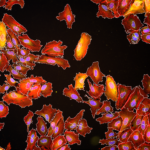Link to Pubmed [PMID] – 12480337
Trends Cell Biol 2003 Jan; 13(1): 23-31
The bacterium Listeria monocytogenes has the unusual capacity to enter and to multiply in nonphagocytic cells. Bacterially induced phagocytosis is triggered mainly by the two surface proteins internalin (also called InlA) and InlB, which interact with host cell receptors and either mimic or act in place of the normal cellular ligands. Internalin interacts specifically with human E-cadherin, whereas InlB activates the tyrosine kinase receptor Met and also interacts with the ubiquitous receptor gC1qR and proteoglycans. Signals induced by crosstalk between the bacterium and the host cell allow internalization, which is a prelude to intracellular multiplication, actin-based movement and spread of the bacterium from cell to cell. Manipulating the bacterial invasion proteins offers us an unprecedented tool with which to understand the complex phenomenon of phagocytosis.





